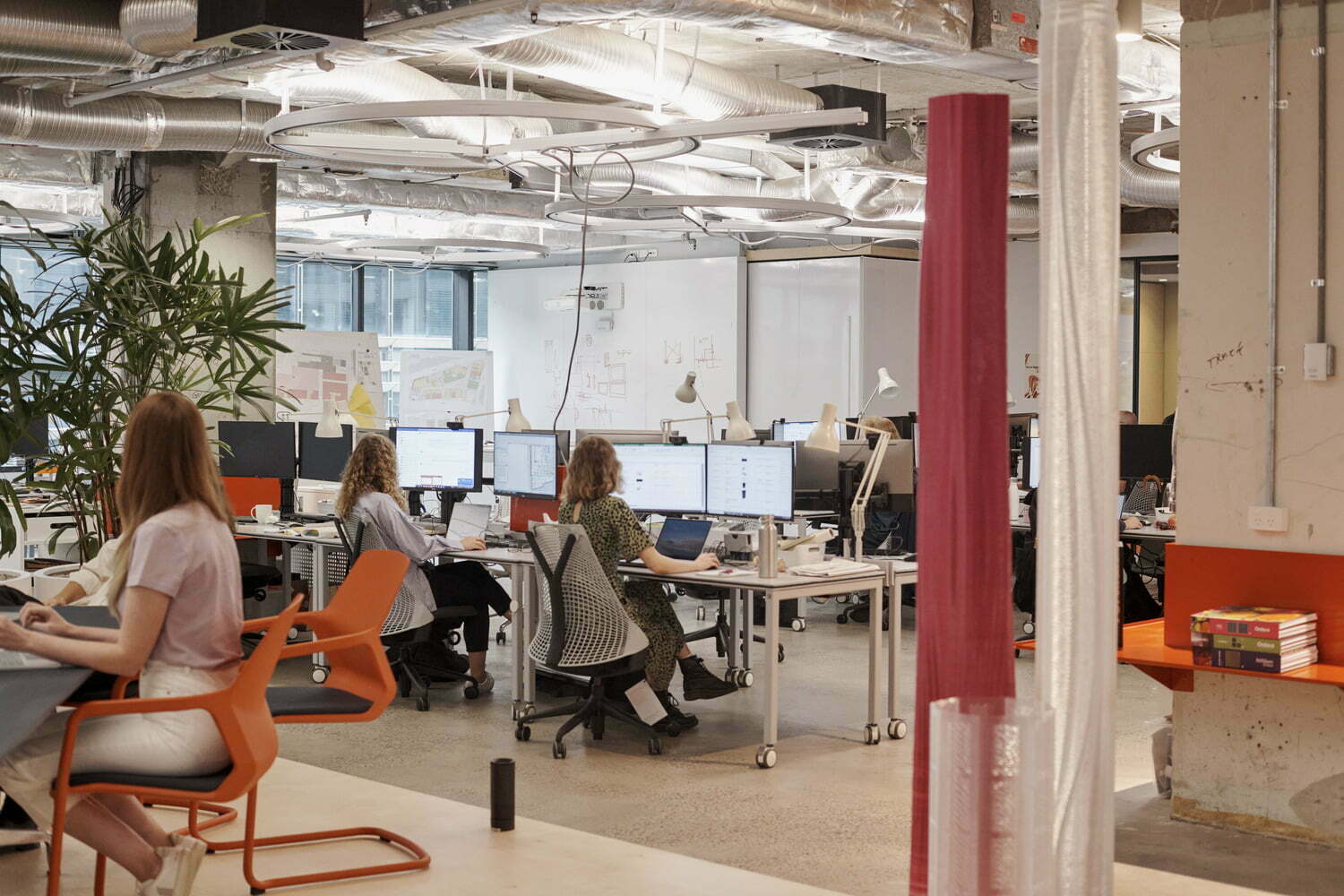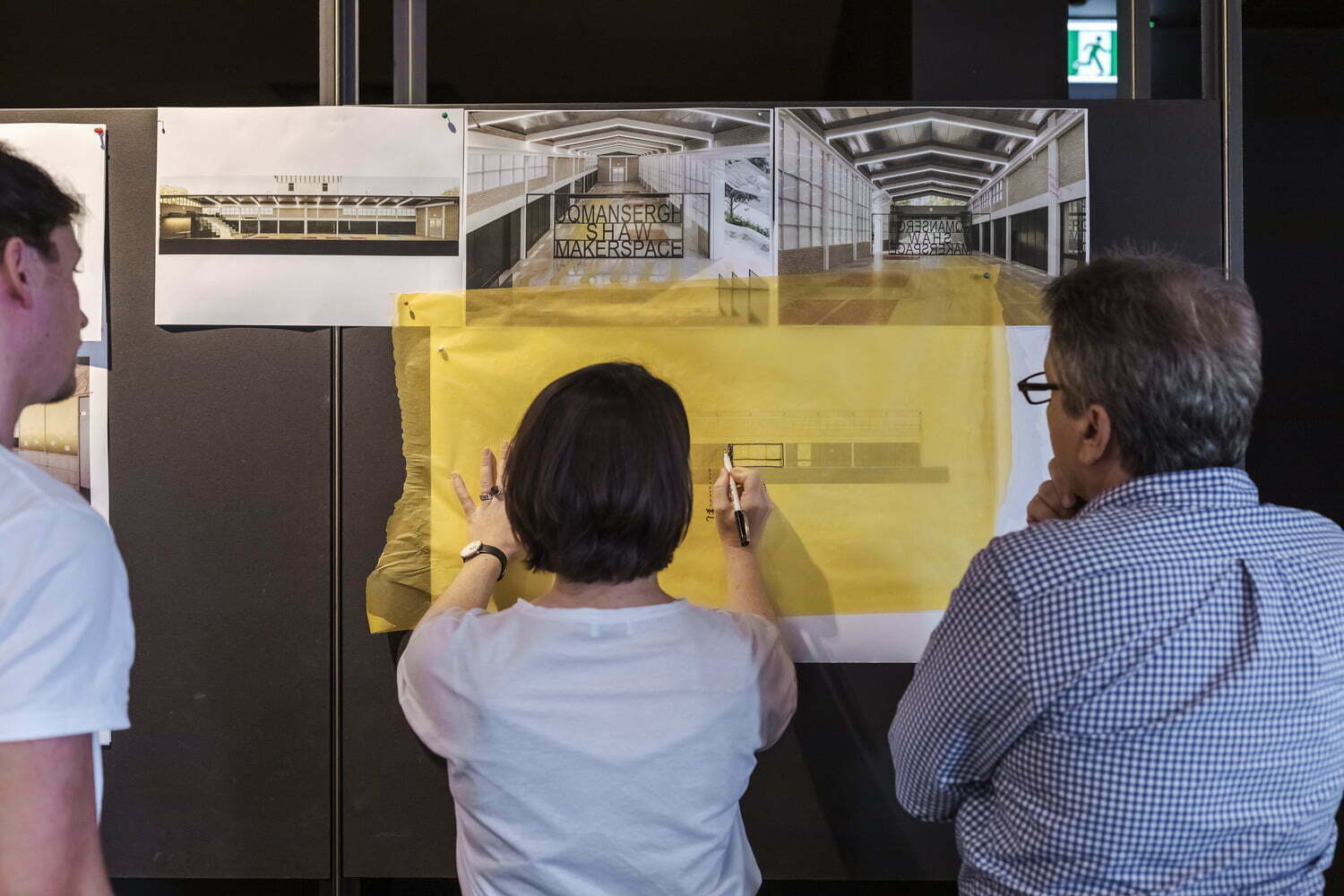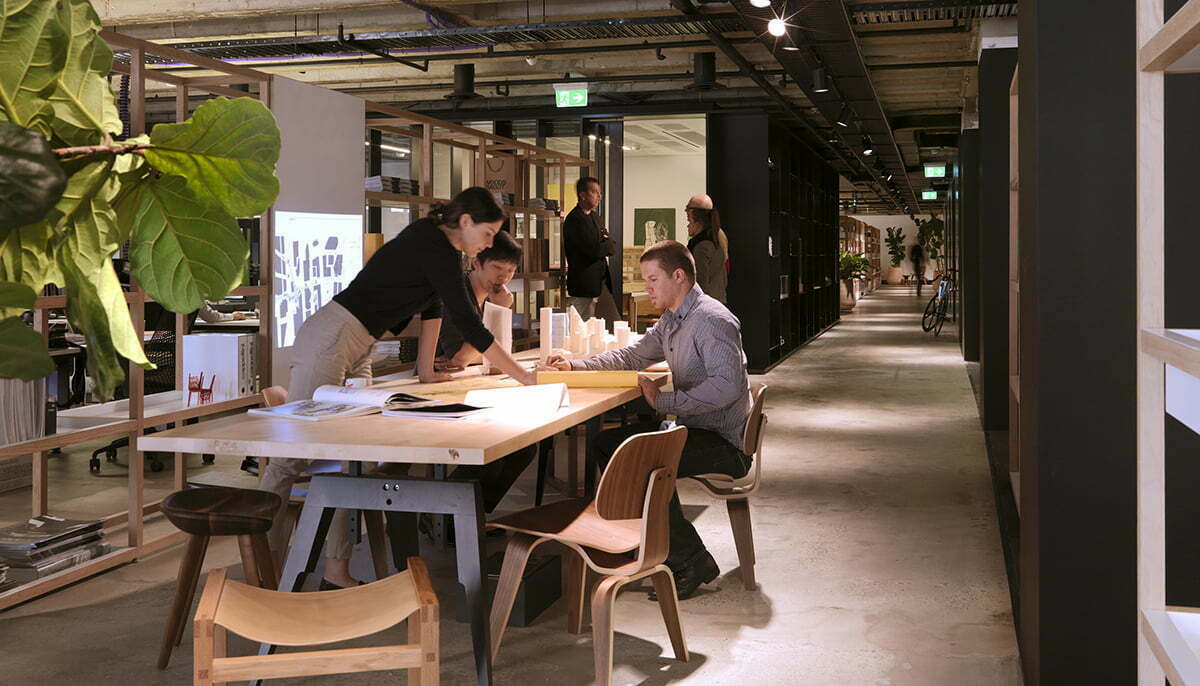How are practices embedding flexible work into their work cultures and everyday habits? BVN, Woods Bagot and Cox share their progress and experiences so far.
BVN

BVN outlines initiatives that have worked in their transition to an All Roles Flex model and now a Hybrid Working Model.
BVN began life 95 years ago in Toowoomba, Queensland, and now numbers 345 people, with studios in Sydney, Brisbane, New York and London.
Using the Champions of Change Flex Policy document as a basis, BVN set about creating a more detailed and bespoke set of guidelines reflecting the needs of our people. Over a number of years, we used the feedback from those on a variety of flexible arrangements to establish the challenges faced by the individuals and the teams. What became evident is the necessity of providing clarity on process of how to apply for a flex arrangement, defining the variety of arrangements (not just working from home), reiterating that flex is open to everyone and reinforcing that each arrangement is subject to a bi‐annual review to ensure they are working for all parties. This gives everyone confidence and comfort on the process and enables a consistent approach to each application.
Weekly clinics
After the publication of the guidelines, we held a series of weekly clinics for a month to explain in detail the intent and process of the guidelines and answer any questions. We published the document and a synopsis on our intranet to ensure transparency and easy access.
Visibility around flex
A number of us in the leadership team are very open about our flexible arrangements – we do this through giving full access to our diaries (no privacy settings so if I’m collecting the kids or at an appointment you can see it in my diary!). We also encourage and lead by example by updating our profiles on intranet with our flex arrangements as part of our personal biography. We believe this empowers others and demonstrates we can successfully progress our careers while utilising flex arrangements. The visibility of leadership team members utilising flex arrangements has a significant impact in terms of giving our people confidence to explore flex options as confirmed in a survey we did seeking feedback from studio on my performance as Studio Director – people stated it was reassuring to see my ‘own’ flex arrangement by setting a positive example for others.
Persistence
There was low levels of engagement early on but with persistence and leadership it was great to see the level of participation grow over 18 months and with it the openness/ transparency of the users. This willingness to share how you balance work and life is really important to foster a culture that supports flexibility. It also acknowledges the challenges of juggling life and work and reinforces that it’s not something to be ashamed or worried about.
We encourage everyone to develop the habit of using a tool (best suited to your culture and point on your flex journey) to grow your collective confidence to foster a healthy work culture underpinned by balance – recognising that we are all in different phases of our lives and balance looks different to everyone!
Feedback and surveys
Avoid tipping your policy into the practice and forgetting about it. Successful implementation is key, and you have to live it. Seek feedback and action it. Use the six-monthly flex survey to gauge sentiment within the practice around flexibility and use this feedback to amend the policy and ensure it’s reflective of the current context (society/industry/ culture).
Transparency for all
The other device which has had a huge impact is the creation of a daily all staff email confirming everyone’s whereabouts. This is generated by logging in to a BVN ‘Whereabouts’ google form and noting any reason for not coming into the studio, going out during the day or if you are coming in after 9.30am. The form automatically generates the email and links with the leave register, thus providing a full picture of people on leave, sick leave, parental leave, working from home, site visits, doctors’ appointments, tutoring and school drop offs – everything! It reinforces that flex is not just about working from home or for people with caring responsibilities and takes away the stigma of being open about reasons for bringing balance to your life. The participation rates are very high and the reasons for people’s movements are expanding all the time as everyone embraces the transparent process.
Different ways of working
The practice is committed to fostering a highly creative, collaborative and supportive work environment. The impact of the pandemic has created a unique opportunity for us to trial working differently including working from home. Through this period of necessity, we have been able to assess the positive and negative aspects on BVN, teams, individuals and projects.
The role of the studio
Collective creativity is at the core of everything we do. It fuels our business, our shared passions and keeps us connected to each other. Coming together physically sparks our creativity. Going forward, we see our studios as hubs for dynamic engagement – a place to create and share ideas. Our studio is where we come together as an organisation, as a team, see our colleagues and friends, and engage and inspire our clients and collaborators. The studio gives us access to things we don’t have at home – the workshop, materials, pin up space, great technology, rooms to meet, optimum desk set ups, events and social activities. It also gives us space and time away from home and engages us in the city. The studio is where we understand that we belong.
Working outside the studio
We also recognise that we can do some of our work outside of the studio. Working outside of the studio helps us balance our personal lives and wellbeing. It gives us the chance to take back the time we spend commuting and redirect that time into the day to flow as we need to. Working outside the studio can help us balance our focused work with the collaborative work we do in the studio.
Hybrid working model
Our goal is to give everyone the best of both worlds, so we are resetting the way we work at BVN to a Hybrid Working Model. This model will be reviewed on a periodic basis and may be subject to change.
Cox

COX Architecture identifies some key takeaways from the implementation process of the All Roles Flex policy.
COX is a design-focused architectural practice with studios in every major Australian city and a history spanning 60 years. The practice employs some 500 talented architects, urban planners, interior designers, researchers, and digital visualisation experts.
COX works within a collegiate framework allowing the best ideas to emerge – we are ‘by the many, for the many’. We seek the brightest minds to innovate our design, processes, and typology. We welcome collaboration, from both traditional and disruptive sources, should it contribute to better design outcomes.
When going through the process of implementing All Roles Flex Policy we found some key takeaways. First, it was important to undertake an internal education process for management and employees in relation to implementing an All-Roles Flex policy. We needed to make sure everyone understood the policy, to whom it applied and how the policy would operate. Many people had some idea, but there were misconceptions and fears that needed to be allayed or dis-spelled. Concerns were that productivity would reduce, there would be no way of judging performance, and that staff would take advantage of flexibility.
We found the best way to overcome these challenges was having key decision makers being champions of the policy and being willing and able to dedicate time to being vocal and active in support of the policy. As with any policy initiative, an All-Roles Flex policy needs to be well considered and to be inclusive. The policy must not stand alone but be supported by strong administrative process, consultation and mechanisms for review and evaluation.
Monitoring and reporting on the ‘take-up’ of the All-Roles Flex policy and how it works in practicality, is important and is critical to ensure the ongoing success of the policy. In the experience of COX, the feedback and performance was positive.
In the future, even more communication and education will be critical. We will need specific agreement on implementation dates by state studios to ensure the rollout to the national practice as a whole.
Woods Bagot

Woods Bagot explains the process of committing to increased flexibility and outlines some of the benefits and challenges as they move forward into the ‘new normal’.
Woods Bagot is a global design and consulting practice working across its network of 16 studios. The practice was founded in Adelaide by Edward John Woods and Walter Bagot in 1869, spanning over 150 years.
We value the diversity of our people and celebrate our ability to work effectively across the globe and across time-zones. We strive to promote a culture of trust and support for individuals to perform their roles and responsibilities with a high level of professionalism. We also recognise that our people have varied and changing personal circumstances, motivations and needs at different stages of their lives and careers. We live by our values and support developing lifelong dynamic careers.
As Woods Bagot promotes a flexible work environment we established a Flexible Working Arrangement Policy, which benefits parents as well as all employees requesting or requiring flexible working arrangements for their life circumstances. When requested by an employee, flexible working options are considered in the form of formal or informal flex. Formal Flex allows employees to access a broader range of flexibility options including working in an alternative/remote location and/or working outside the standard office hours. This allows employees to continue in our hybrid working environment and enabling the rich studio culture engagement while being on their terms.
Informal Flex
Informal Flex includes temporary and irregular arrangements that can be negotiated on an as needed basis, without the necessity for contractual negotiations. Informal Flex is designed to help balance ad hoc personal commitments and assist with supporting a healthy work life balance, in addition to meeting work commitments.
An employee who requires Informal Flex speaks with their manager or project leader as soon as the need is required. This arrangement requires clear communication between employee and manager or project leader and team.
Formal Flex
Formal Flex allows an employee to access more permanent structured and ongoing flexible work options.
To access formal flex arrangements, employees outline the suitability of the proposed flexible working arrangements within their current role, how this enables them to continue meeting project deliverables and does not impact the team. This is submitted to the employee’s manager and/or project leader for consideration and discussion.
Like the nature of project work within a global environment, the formal flex agreement needs to be continually reviewed as project requirements shift, and needs to flex due to the nature or phase of the project. The manager and/or project leader is able to discuss working arrangements and considerations over time.
Flexibility and the ‘new normal’
It is important to implement a policy and procedure that fits the language and culture of the organisation. Flex has moved from being a gendered issue to a culture issue. To support gender equality in our industry we need to solve flexibility as a workplace culture issue where we make flexibility work for employees and embrace this shift. The COVID environment has shown that flex is possible for all roles. As we go back to the ‘new normal’ the challenge is to not fall back into our previous patterns and expectations of ‘presenteeism’ or a virtual version of ‘always available’ culture.
The challenge is also how we successfully integrate teams that are split between remote working and studios that still allows for equal opportunities and inclusiveness and doesn’t bias one over the other.
We know from conducting annual engagement surveys that one of the top priorities is work life balance and many see that flexible work practices are key to establishing trust and autonomy between staff, and leadership and accountability for the performance of work. Flexible work arrangements rely on improved communication and clarity of roles and responsibilities. Working flexibly is no longer a perk. It’s now an expectation.
For more information on incorporating flexibility into practice, see What is Flexibility & Why Does it Matter?, and How to Create an Effective Flex Policy and watch the recording of the On Flexibility discussion.




















